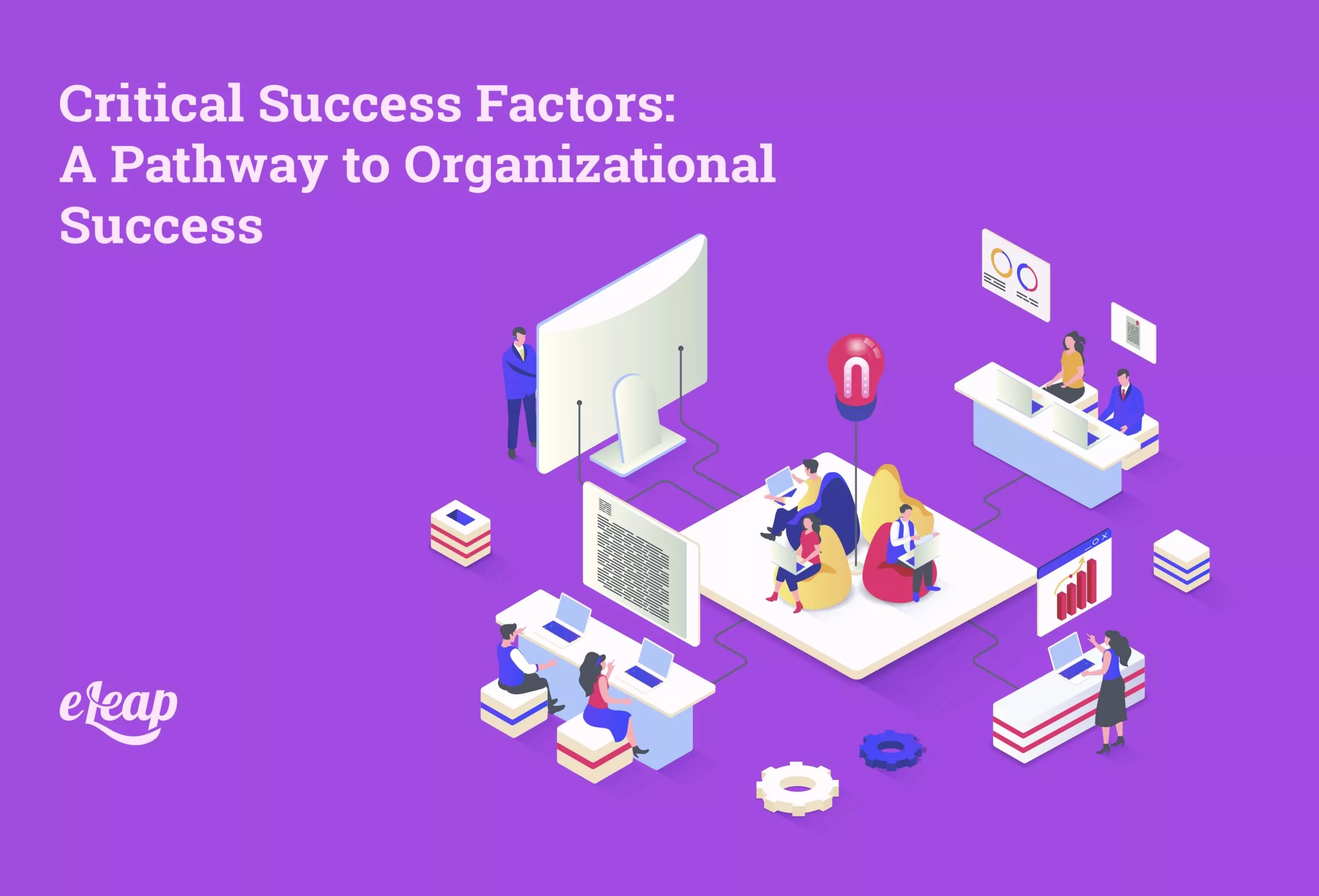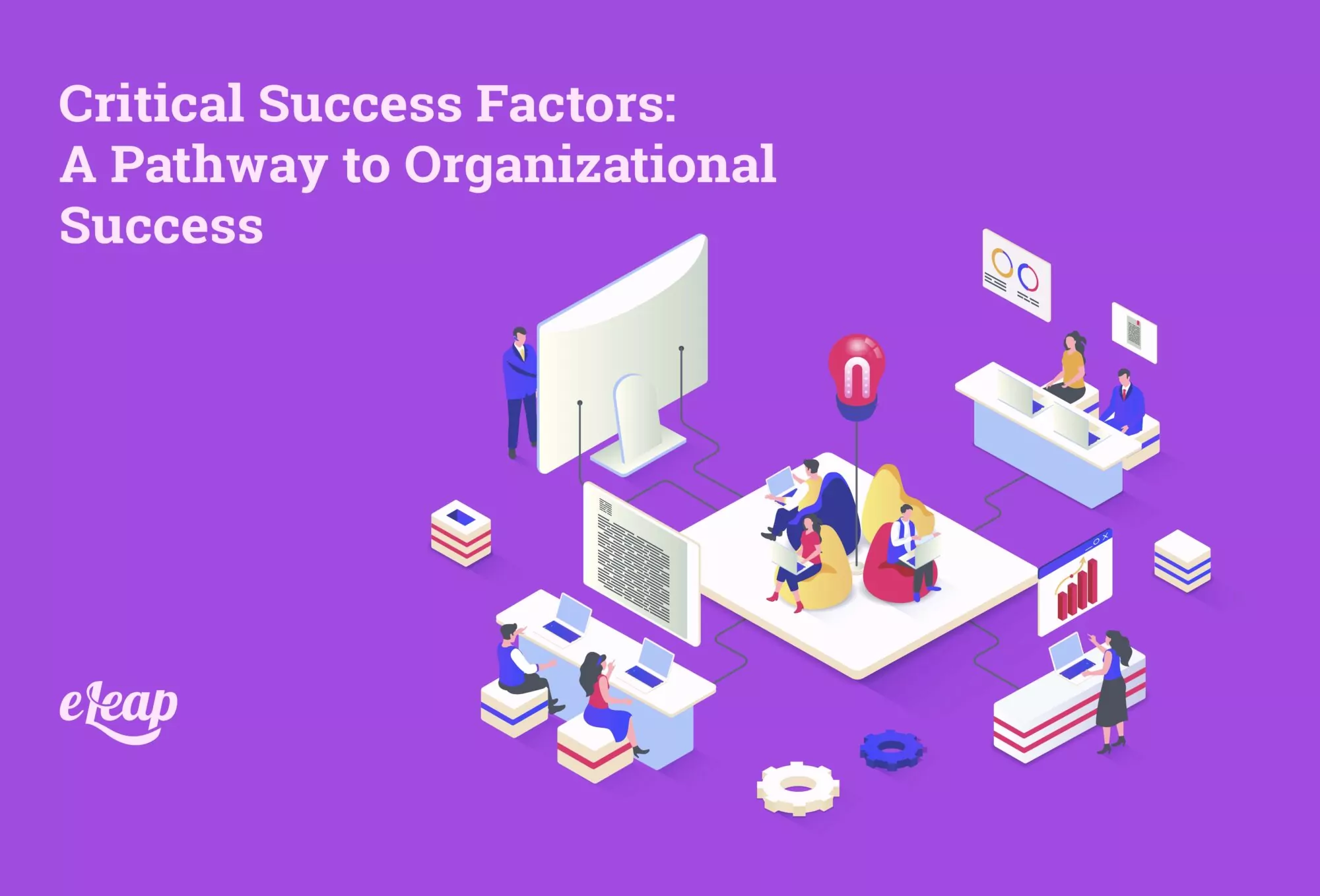Critical Success Factors: A Pathway to Organizational Success

Critical Success Factors (CSFs) are fundamental to the success of any organization. These are the key areas that organizations must focus on to achieve their strategic goals and overall success. Whether you are a small business or a large enterprise, understanding and identifying CSFs can be the difference between thriving or merely surviving in the business landscape. In this article, we’ll explore Critical Success Factors, why they are crucial for your business, and how you can identify and implement them to drive long-term success. See how eLeaP®’s Performance Management Platform helps you apply these insights to drive better results.
What Are Critical Success Factors (CSFs)?
Critical Success Factors (CSFs) are the vital areas of activity that must be performed well for an organization to achieve its mission and strategic objectives. Simply put, CSFs are the essential elements that make or break an organization’s success. These factors are typically aligned with a company’s long-term goals and strategies. They range from product innovation, operational efficiency, and customer satisfaction to workforce capability, financial performance, and regulation compliance.
Organizations that identify and focus on their CSFs in a highly competitive business environment can more effectively allocate resources, manage risks, and stay ahead of the competition. Unlike general performance indicators, CSFs are directly tied to strategic priorities, ensuring that businesses are on the path to meeting their overarching goals.
Understanding what constitutes a CSF for your organization is critical. It requires careful analysis of your business model, competitive advantages, market trends, and internal capabilities. However, identifying these key factors is the first step in leveraging them to ensure success.
Why Are Critical Success Factors Essential for Organizational Success?
Critical Success Factors are the foundation for effective business strategy. They align your organization’s efforts with its strategic goals, ensuring you are moving in the right direction. Without a clear understanding of your CSFs, it’s easy to lose sight of what’s most essential and waste resources on activities that do not contribute to long-term growth.
The Strategic Importance of CSFs
CSFs influence decision-making at every level of the organization. They guide executives in setting goals and priorities, help managers evaluate performance, and provide a clear direction for the entire team. Identifying CSFs enables businesses to focus their attention on what matters—whether it’s customer retention, operational excellence, or innovation.
Take, for example, a technology company aiming to scale its operations. A key CSF for such a company might be “product innovation.” Without consistent innovation, the company could fall behind competitors, introducing new, cutting-edge solutions. On the other hand, a healthcare organization may identify “regulatory compliance” as a CSF, ensuring they meet industry standards and avoid legal pitfalls.
Real-Life Examples of CSFs
Many successful companies attribute their growth and sustainability to their ability to identify and act upon their Critical Success Factors. Consider Amazon, which has consistently focused on the CSF of “customer-centricity” since its inception. By relentlessly focusing on customer satisfaction, Amazon has dominated the e-commerce space. Similarly, companies like Apple have a CSF of “innovation,” enabling them to develop products that set new market trends consistently.
Organizations that successfully integrate their CSFs into their business strategies can gain a competitive advantage, maintain a loyal customer base, and achieve long-term sustainability.
The Process of Identifying Critical Success Factors
Identifying your organization’s CSFs requires a systematic approach. It’s not enough to guess or assume what will drive success. The process must involve careful analysis of both external and internal factors that can influence performance.
Align CSFs with Organizational Vision and Strategy

The first step in identifying your CSFs is ensuring they align with your company’s vision, mission, and strategic goals. If your organization is focused on growth and market expansion, your CSFs might include increasing market share, improving brand recognition, or enhancing customer service. If your organization focuses more on operational efficiency, your CSFs could include optimizing supply chains or reducing operational costs.
To align CSFs with your organization’s strategy, you must involve leadership in setting clear priorities and ensuring these factors resonate throughout the business. For example, eLeaP, a performance management and employee training software, emphasizes employee development as a CSF for organizations looking to increase productivity and reduce turnover. Companies can create a highly skilled and motivated workforce by aligning talent development with the organization’s strategic goals.
Analyze External and Internal Environments
Market trends, economic conditions, and industry regulations influence CSFs. For example, compliance could be a key CSF if you’re operating in a highly regulated industry. On the other hand, internal factors such as organizational culture, resources, and capabilities will also play a significant role in shaping your CSFs.
In a tech-driven business, innovation might be a CSF due to rapid technological advancements. In contrast, a manufacturing company might identify process efficiency and supply chain management as CSFs due to the high demand for low-cost, high-quality production.
Engage Stakeholders for Input
To ensure your CSFs are comprehensive and realistic, involve key organizational stakeholders. Managers, employees, and even customers can provide invaluable insights into what truly matters for success. Engaging different departments will help to identify internal and external challenges, uncover new opportunities, and ensure that the CSFs are actionable.
For instance, if a company wants to improve customer satisfaction, involving customer service teams will allow you better to understand the pain points and areas for improvement. Likewise, input from product development teams can help you determine if innovation and product features are indeed a CSF.
Prioritize CSFs Based on Impact and Feasibility
Once you’ve identified potential CSFs, it’s essential to prioritize them. Not every CSF will have the same level of impact, and some may be more feasible to implement than others. For example, a company may decide that operational efficiency is the highest priority for the year, with customer satisfaction being a close second. Prioritizing these factors will ensure the organization focuses its resources on the most critical areas.
Examples of Critical Success Factors Across Various Industries
Critical Success Factors vary from one industry to another. What works for one organization may not apply to another. Understanding the specific CSFs for your industry can provide you with a roadmap for success.
Technology and Innovation
CSFs like “innovation” and “time to market” are crucial in the tech industry. Tech companies must constantly innovate and market new products or features that are taster than competitors’. For instance, Apple’s focus on innovation and design excellence has made it one of the most successful tech companies in the world.
Healthcare
For healthcare organizations, CSFs may include “regulatory compliance,” “patient care quality,” and “cost management.” Healthcare providers must navigate complex regulatory environments, ensure patient safety and satisfaction, and manage operational costs effectively.
Manufacturing
In manufacturing, CSFs could be “operational efficiency,” “quality control,” and “supply chain management.” Companies need to ensure their production processes are efficient and cost-effective while maintaining high standards for product quality.
Small and Medium Enterprises (SMEs)
Customer acquisition and retention are often the top CSFs for small businesses. Many SMEs also focus on “cost management” and “brand recognition” to build credibility in their industry.
Service-Based Industries
Customer satisfaction and “service delivery” are the primary CSFs in service-based industries. Companies must build strong client relationships and ensure services are delivered promptly, effectively, and customer-friendly.
Implementing Critical Success Factors: Turning Strategy into Action
Identifying CSFs is only the first step. The next challenge is turning those factors into actionable plans that drive results.
Developing Actionable Plans for CSF Implementation
Once you’ve identified your CSFs, developing specific implementation plans is crucial. These plans should outline the actions, resources, and timelines needed to achieve each CSF. Clear objectives and deadlines help to ensure that everyone in the organization is aligned and accountable.
Resource Allocation and Management for CSF Success
For CSFs to be achieved, you must allocate the right resources, whether time, money, or personnel. For example, if customer satisfaction is a CSF, investing in a dedicated customer support team, implementing CRM software, or providing additional staff training may be required.
Continuous Monitoring and Adaptation
The business landscape is constantly evolving. Regular monitoring and adjustment of your CSFs will help ensure your business remains on track to meet its objectives. Tools like performance dashboards and KPIs can help you assess your CSFs’ effectiveness and make necessary real-time adjustments.
How to Measure the Effectiveness of Critical Success Factors
The final step in leveraging CSFs is measuring their success. Effective measurement ensures that you stay on track and optimize for more tremendous success.
Defining and Aligning KPIs with CSFs
Key Performance Indicators (KPIs) are essential for tracking the effectiveness of your CSFs. When selecting KPIs, ensure they are directly linked to your identified CSFs. For example, if innovation is a CSF, a relevant KPI might be the number of new products launched in a year.
Tracking Progress and Identifying Gaps
Regularly tracking your CSF progress allows you to pinpoint any gaps in performance and make adjustments. Dashboards and automated reporting tools can help you monitor critical data and meet your strategic goals.
Overcoming Common Challenges in Managing Critical Success Factors
Even with well-defined CSFs, challenges can arise. Some of the most common hurdles include aligning the organization’s culture with its CSFs, limited resources, and external market changes. Overcoming these challenges requires effective leadership, strong communication, and a willingness to adapt strategies when necessary.
Conclusion
Critical Success Factors are indispensable to achieving long-term business success. By carefully identifying and focusing on the areas that truly matter, organizations can better align their resources, strategies, and actions with their goals. Understanding your CSFs will give you the clarity and direction needed to succeed, whether a small business or a large corporation. Take action today, and start implementing your CSFs with a clear focus on what drives your business forward.